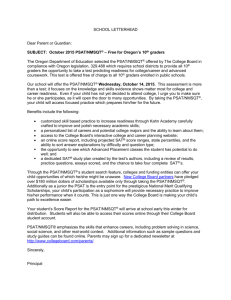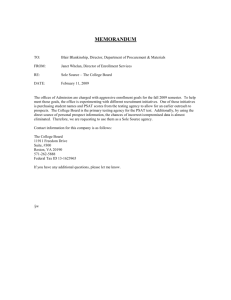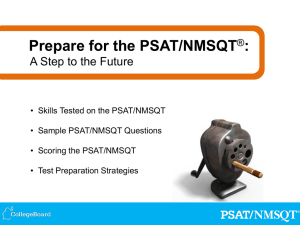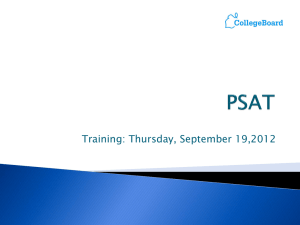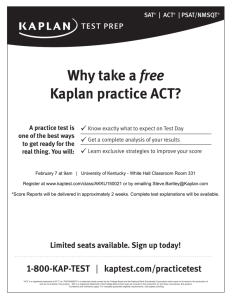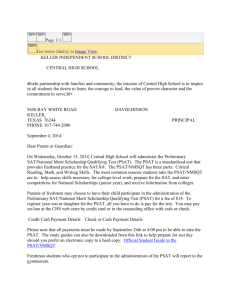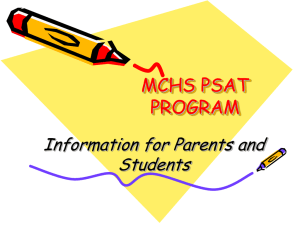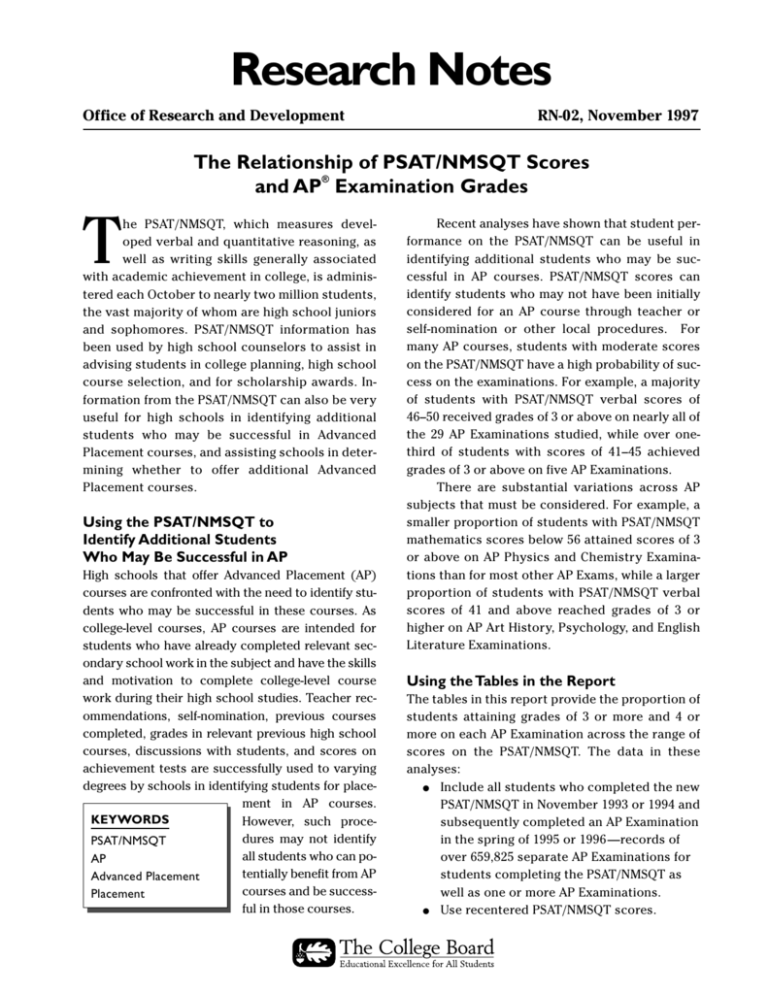
Research Notes
Office of Research and Development
RN-02, November 1997
The Relationship of PSAT/NMSQT Scores
and AP® Examination Grades
T
he PSAT/NMSQT, which measures developed verbal and quantitative reasoning, as
well as writing skills generally associated
with academic achievement in college, is administered each October to nearly two million students,
the vast majority of whom are high school juniors
and sophomores. PSAT/NMSQT information has
been used by high school counselors to assist in
advising students in college planning, high school
course selection, and for scholarship awards. Information from the PSAT/NMSQT can also be very
useful for high schools in identifying additional
students who may be successful in Advanced
Placement courses, and assisting schools in determining whether to offer additional Advanced
Placement courses.
Using the PSAT/NMSQT to
Identify Additional Students
Who May Be Successful in AP
High schools that offer Advanced Placement (AP)
courses are confronted with the need to identify students who may be successful in these courses. As
college-level courses, AP courses are intended for
students who have already completed relevant secondary school work in the subject and have the skills
and motivation to complete college-level course
work during their high school studies. Teacher recommendations, self-nomination, previous courses
completed, grades in relevant previous high school
courses, discussions with students, and scores on
achievement tests are successfully used to varying
degrees by schools in identifying students for placement in AP courses.
KEYWORDS
However, such procedures may not identify
PSAT/NMSQT
all students who can poAP
tentially benefit from AP
Advanced Placement
courses and be successPlacement
ful in those courses.
Recent analyses have shown that student performance on the PSAT/NMSQT can be useful in
identifying additional students who may be successful in AP courses. PSAT/NMSQT scores can
identify students who may not have been initially
considered for an AP course through teacher or
self-nomination or other local procedures. For
many AP courses, students with moderate scores
on the PSAT/NMSQT have a high probability of success on the examinations. For example, a majority
of students with PSAT/NMSQT verbal scores of
46–50 received grades of 3 or above on nearly all of
the 29 AP Examinations studied, while over onethird of students with scores of 41–45 achieved
grades of 3 or above on five AP Examinations.
There are substantial variations across AP
subjects that must be considered. For example, a
smaller proportion of students with PSAT/NMSQT
mathematics scores below 56 attained scores of 3
or above on AP Physics and Chemistry Examinations than for most other AP Exams, while a larger
proportion of students with PSAT/NMSQT verbal
scores of 41 and above reached grades of 3 or
higher on AP Art History, Psychology, and English
Literature Examinations.
Using the Tables in the Report
The tables in this report provide the proportion of
students attaining grades of 3 or more and 4 or
more on each AP Examination across the range of
scores on the PSAT/NMSQT. The data in these
analyses:
• Include all students who completed the new
PSAT/NMSQT in November 1993 or 1994 and
subsequently completed an AP Examination
in the spring of 1995 or 1996 —records of
over 659,825 separate AP Examinations for
students completing the PSAT/NMSQT as
well as one or more AP Examinations.
• Use recentered PSAT/NMSQT scores.
Research Notes
•
•
AP Examinations. It is impossible to know how students would have performed on AP Examinations
when they have not enrolled in AP courses. It is
quite likely that students who completed AP Examinations differ in meaningful ways from students
who did not complete AP Examinations, even when
they attain the same PSAT/NMSQT scores and complete the same courses with equal proficiency.
Therefore, these tables have not been developed
to provide the precise probability for an individual
student’s attaining a specific AP Examination
grade, but rather to provide the probability of success in AP courses for the group of students attaining PSAT/NMSQT scores within a given range.
Nevertheless, students with moderate
PSAT/NMSQT scores are typically successful when
completing many AP Examinations. Students who
have completed the prerequisite secondary
school courses and have not considered AP courses
can be identified for further consideration by faculty and counselors with the use of performance
data from the PSAT/NMSQT.
To use these tables you would first find the
appropriate AP Examination. Then you would determine which PSAT/NMSQT scale to use (verbal,
mathematics, or V + M for biology only). Next, you
would identify students’ respective scores on the
appropriate PSAT/NMSQT scale and find the proportion expected to attain grades of 3 or more (or
4 or more if appropriate). This is clearly labeled
on the tables. Table 1 lists AP courses that use the
PSAT/NMSQT verbal scale, Table 2 lists AP courses
using the PSAT/NMSQT mathematics scale, and a
separate table is provided for biology (Table 3),
which combines both scales. There should be no
absolute rules for interpreting or using these tables. For example, with U.S. History, you may use
score ranges of 41–45, 46–50, or 51–55 to begin to
identify potential students because at these points
sizable numbers of students have received grades
of 3 or more in the past. Many students identified
through this means may have already been considered for AP U.S. History through other procedures already instituted in the school (e.g.,
teacher recommendations). Yet the use of the
Include students who completed the
PSAT/NMSQT one year prior to enrolling in
an AP course (about 70 percent of the sample) as well as students who completed the
PSAT/NMSQT during the same year they
completed the AP Examination. In the former case, there was about an 18-month duration between tests, while the gap was reduced to six months in the latter situation.
Demonstrate that while the relationships
(correlation coefficients) were somewhat
stronger for students taking both examinations during the same year, these correlations decreased only slightly for students
completing the PSAT/NMSQT a year prior to
enrolling in AP courses. This finding in particular demonstrated the utility of using
PSAT/NMSQT scores to assist in identifying
potential students for AP courses.
PSAT/NMSQT scores can supplement existing
procedures used by schools to identify additional
students who may be successful in specific AP
courses, but should never be used as the sole, or
even the primary, indicator. Schools should not establish minimum “cut scores” on the PSAT/NMSQT
or any other assessment for placing students into
AP courses—such practices are a clear misuse of
assessment scores. Faculty and counselors should
be cautious in using these tables. First, many students with PSAT/NMSQT scores that place them at
the upper ranges of probable success (grades of 3
or higher) for a specific AP Examination may not
have fulfilled the appropriate prerequisite courses
and would clearly be unprepared for some AP
courses. Second, student performance (grades,
teacher recommendations) in previous courses in
the content area as well as motivation and interest
will be key determinants of their success in AP
courses and must be considered. Third, the sample
of students used in the analysis was restricted to
students who did complete an AP Examination.
That is, while the sample of students was quite
large, it did not include the large number of
PSAT/NMSQT test takers who do not complete any
Copyright © 1997 by College Entrance Examination Board. All rights reserved. College Board, AP, and the acorn logo are registered trademarks
of the College Entrance Examination Board.
Permission is hereby granted to any nonprofit organization or institution to reproduce this report in limited quantities for its own use, but not
for sale, provided that the copyright notice be retained in all reproduced copies exactly as it appears in this publication.
2
Research Notes
Course Selection Patterns in Math and Science*
Exams that correlate best
with PSAT/NMSQT Verbal
Exams that correlate best
with PSAT/NMSQT Math
Art History
Comparative Government and Politics
English Language
English Literature
European History
French Language
French Literature
Latin Literature
Latin Vergil
Psychology
Spanish Literature
U.S. Government and Politics
U.S. History
Calculus AB
Calculus BC
Chemistry
Computer Science A
Computer Science AB
Macroeconomics
Microeconomics
Music
Physics B
Physics C: Mechanics
Physics C: Electricity & Magnetism
Exams that have no meaningful
correlation with PSAT/NMSQT
Exams that correlate best
with PSAT/NMSQT Verbal & Math
German Language
Spanish Language
Studio Art: Design
Studio Art: Drawing
Biology
* In 1997, the PSAT/NMSQT introduced a writing skills section. Correlations with writing cannot be examined at this
time because there are no operational data available on student performance.
PSAT/NMSQT score range can help identify additional potential students who may be considered
for the course. Counselors and teachers would
need to determine if these students have had the
appropriate prerequisite courses and would also
need to consider their performance in these
courses, as well as student interest and motivation for completing a rigorous college-level AP
course. In essence, these tables cannot provide
one-stop shopping in curriculum planning, but can
serve as useful aids and supplements to other
methods used in the school.
subject for some examinations. The PSAT/NMSQT
verbal scale correlates most strongly with student
performance on 13 AP Examinations in the humanities, social sciences, and foreign language areas
(see Table 4). The PSAT/NMSQT mathematics
scale correlates most strongly with 11 additional
AP Examinations in mathematics, science, and music. AP Biology correlates most strongly with combined scores across the verbal and mathematics
scales for the PSAT/NMSQT.
Finally, the relationships between four AP Examinations and PSAT/NMSQT test scores are too
low to be useful. Performance on the PSAT/NMSQT
is not strongly related to AP Examination grades
for studio art: design, studio art: drawing, German
language, and Spanish language. The studio art
courses are graded exclusively with studentproduced portfolios and traditional examinations
are not used. The relationship with most language
examinations appears weaker than it is for other
content areas, but the lack of any relationship for
Spanish language may be attributed to the large
proportion of students enrolled in this specific
Strength of the Relationship Between AP
Examinations and PSAT/NMSQT
There is a strong and consistent relationship between PSAT/NMSQT scores and AP Examination
grades for nearly all courses—higher scores on
the PSAT/NMSQT indicate a higher probability of
success on AP Examinations. PSAT/NMSQT verbal
or mathematics scores are often more highly related to AP Examination grades than overall high
school GPA, number of courses in the subject
area, and even previous high school grades in the
Continued on 7
3
Research Notes
TABLE 1
AP Examinations Using PSAT/NMSQT Verbal Scores
Percentage of Students with a Particular PSAT/NMSQT Verbal Score
Receiving an AP Examination Grade at or Above 3 or 4
AP COMPARATIVE GOVERNMENT
AND POLITICS
AP ART HISTORY
C O M PA R AT I V E G OV E R N M E N T
AND POLITICS
ART HISTORY
AP GRADE
≥3
≥4
80–76
100.0
90.4
75–71
97.9
70–66
93.8
65–61
60–56
AP GRADE
PSAT V Score
≥3
≥4
n
52
80–76
94.7
67.9
56
81.7
235
75–71
92.9
66.2
266
72.6
391
70–66
88.2
57.1
469
92.4
61.7
781
65–61
82.0
46.3
922
88.6
49.5
893
60–56
74.5
34.4
916
55–51
82.8
42.4
1,115
55–51
67.6
23.7
1,321
50–46
77.6
29.1
1,043
50–46
53.9
16.4
1,057
45–41
67.5
20.9
831
45–41
42.4
9.8
662
40–36
53.4
12.4
412
40–36
28.5
5.4
333
35–31
39.5
5.4
185
35–31
21.2
2.9
104
30–26
37.1
3.2
62
30–26
18.2
—
33
25–20
30.7
5.1
39
25–20
—
—
18
Total
—
—
6,039
Total
—
—
6,157
PSAT V Score
n
AP ENGLISH LANGUAGE
AP ENGLISH LITERATURE
ENGLISH LANGUAGE
ENGLISH LITERATURE
AP GRADE
PSAT V Score
≥3
≥4
80–76
99.3
75–71
97.9
70–66
65–61
AP GRADE
n
PSAT V Score
≥3
≥4
91.7
446
80–76
99.6
95.5
485
85.4
1,826
75–71
99.2
91.3
3,652
95.9
73.0
3,763
70–66
97.9
82.5
7,275
90.3
58.8
7,784
65–61
95.8
69.9
16,211
60–56
77.7
39.1
9,031
60–56
90.6
52.9
17,774
55–51
66.5
23.9
12,922
55–51
80.4
35.3
26,880
50–46
48.0
10.9
12,363
50–46
62.2
17.7
25,267
45–41
28.2
3.6
8,206
45–41
39.4
7.0
16,063
40–36
12.6
1.0
4,501
40–36
20.2
2.1
8,117
35–31
4.8
0.6
1,797
35–31
6.8
0.8
3,060
30–26
2.8
1.0
512
30–26
3.8
0.6
888
25–20
2.4
1.2
257
25–20
2.6
0.3
400
Total
—
—
63,408
Total
—
—
126,072
4
n
Research Notes
TABLE 1 (continued)
AP Examinations Using PSAT/NMSQT Verbal Scores
Percentage of Students with a Particular PSAT/NMSQT Verbal Score
Receiving an AP Examination Grade at or Above 3 or 4
AP EUROPEAN HISTORY
AP FRENCH LANGUAGE
EUROPEAN HISTORY
FRENCH LANGUAGE
AP GRADE
AP GRADE
PSAT V Score
≥3
≥4
n
PSAT V Score
≥3
≥4
n
80–76
98.7
83.9
799
80–76
96.3
74.1
212
75–71
97.8
78.0
2,533
75–71
91.9
68.2
864
70–66
95.7
64.1
5,030
70–66
84.8
53.4
1,404
65–61
90.8
51.6
8,965
65–61
79.2
44.9
2,256
60–56
83.2
38.1
9,688
60–56
67.7
33.0
2,075
55–51
75.4
28.3
11,742
55–51
61.0
26.9
2,574
50–46
65.0
19.5
9,740
50–46
53.1
22.3
2,084
45–41
51.7
11.2
5,854
45–41
45.5
20.4
1,243
40–36
37.2
6.5
2,758
40–36
43.6
21.8
661
35–31
25.3
3.0
971
35–31
44.6
28.8
278
30–26
23.0
4.1
270
30–26
—
—
105
25–20
17.0
7.8
141
25–20
—
—
78
Total
—
—
58,491
Total
—
—
13,834
AP FRENCH LITERATURE
AP LATIN LITERATURE
FRENCH LITERATURE
LATIN LITERATURE
AP GRADE
AP GRADE
PSAT V Score
≥3
≥4
PSAT V Score
≥3
≥4
80–76
97.6
85.7
75–71
96.6
78.2
42
80–76
90.7
68.8
32
175
75–71
88.1
60.5
185
70–66
92.0
66.5
65–61
81.0
54.3
201
70–66
86.5
56.5
230
305
65–61
75.0
40.1
384
60–56
70.3
55–51
66.4
39.6
225
60–56
62.4
26.4
314
31.2
271
55–51
51.3
18.5
355
50–46
45–41
53.6
21.2
177
50–46
50.4
14.5
302
47.4
13.4
97
45–41
38.8
8.6
139
40–36
31.6
7.7
60
40–36
35–31
—
—
19
35–31
27.7
1.5
65
18.5
—
27
30–26
—
—
9
30–26
25–20
—
—
7
25–20
—
—
5
—
—
3
Total
—
—
1,588
Total
—
—
2,041
n
5
n
Research Notes
TABLE 1 (continued)
AP Examinations Using PSAT/NMSQT Verbal Scores
Percentage of Students with a Particular PSAT/NMSQT Verbal Score
Receiving an AP Examination Grade at or Above 3 or 4
AP LATIN VERGIL
AP PSYCHOLOGY
LATIN VERGIL
PSYCHOLOGY
AP GRADE
PSAT V Score
≥3
≥4
80–76
93.8
80.0
75–71
89.8
70–66
86.2
65–61
60–56
AP GRADE
PSAT V Score
≥3
≥4
n
65
80–76
98.0
94.1
51
67.6
306
75–71
98.1
92.5
266
57.5
442
70–66
97.6
86.8
554
77.7
43.6
660
65–61
95.1
79.0
1,326
68.0
31.8
616
60–56
91.0
67.9
1,479
55–51
57.2
23.5
697
55–51
84.9
55.2
2,306
50–46
50.6
17.7
554
50–46
73.6
42.3
2,272
45–41
36.0
6.7
345
45–41
59.3
27.7
1,742
40–36
27.6
8.2
134
40–36
42.1
16.5
1,009
35–31
17.1
4.3
47
35–31
28.1
9.2
380
30–26
—
—
5
30–26
15.0
4.5
133
25–20
—
—
7
25–20
20.7
4.8
63
Total
—
—
3,878
Total
—
—
11,581
n
AP U.S. GOVERNMENT
AND POLITICS
AP U.S. HISTORY
U.S. GOVERNMENT
AND POLITICS
U.S. HISTORY
AP GRADE
AP GRADE
PSAT V Score
≥3
≥4
n
PSAT V Score
≥3
≥4
80–76
95.1
83.0
1,480
80–76
98.2
84.6
162
75–71
93.6
78.2
5,448
75–71
97.4
81.8
1,083
70–66
87.7
66.5
11,863
70–66
94.7
69.0
2,084
65–61
80.3
54.3
23,977
65–61
90.1
55.8
4,523
60–56
68.1
39.6
28,211
60–56
82.7
43.4
4,699
55–51
59.9
31.2
38,472
55–51
74.0
32.7
7,160
50–46
47.4
21.2
36,164
50–46
59.9
19.5
6,752
45–41
35.0
13.4
24,278
45–41
42.8
11.0
4,540
40–36
23.8
7.7
13,165
40–36
27.1
5.3
2,325
35–31
14.7
4.8
5,167
35–31
15.8
2.6
912
30–26
9.6
2.9
1,543
30–26
12.0
2.6
308
25–20
7.8
2.4
744
25–20
6.9
2.3
131
Total
—
—
190,512
Total
—
—
34,679
6
n
Research Notes
PSAT/NMSQT score ranges, schools can quickly
identify the potential number of students who may
be successful in specific AP courses if these were
offered or enrollment was expanded. Schools
would first determine the appropriate proportion
of students with a probability of achieving an AP
grade of 3 or higher to offer or expand an AP
course at their school. Some schools may believe a
50 percent success rate is adequate, other schools
may prefer a slightly lower or slightly higher proportion. Next, the school would determine the
number of students who attain the corresponding
PSAT/NMSQT score. Finally, the school would estimate the approximate number of these students
who would likely have completed the prerequisite
courses and be interested in AP. This information
can be extremely useful for schools considering
offering additional AP courses, as well as those interested in offering additional AP sections of the
same course.
TABLE 1 (continued)
AP SPANISH LITERATURE
SPANISH LITERATURE
AP GRADE
PSAT V Score
≥3
≥4
n
80–76
100.0
82.6
23
75–71
97.0
80.1
136
70–66
95.7
68.1
210
65–61
91.1
61.2
415
60–56
90.7
53.6
407
55–51
84.3
47.8
550
50–46
77.9
43.0
581
45–41
76.1
39.6
523
40–36
77.2
37.1
461
35–31
73.9
31.3
326
30–26
70.4
30.1
216
25–20
55.9
17.6
193
—
—
4,041
Total
Additional Thoughts
In some schools and for certain subjects,
PSAT/NMSQT scores may not be available in time
to make decisions about entry into AP courses.
This is certainly the case where students complete the PSAT/NMSQT in October of their junior
year and a full-year AP course is offered exclusively to juniors. In addition, scores obtained in
eleventh grade cannot be used if the mathematics
or foreign language sequence begins in the eighth
or ninth grades and students have not taken the
required prerequisite courses. Of course, increasing proportions of students are completing the
PSAT/NMSQT as sophomores and their scores can
be helpful for placement in AP courses that begin
after the receipt of student score reports.
course who may have acquired language skills
outside of the classroom (native speakers or students for whom Spanish is spoken at home). The
remaining relationships between specific AP Examinations and PSAT/NMSQT scales are consistent across content areas.
Of the 25 AP Examinations included in this report, 16 examinations have a correlation of greater
than .50 with PSAT/NMSQT scales, with median and
mean correlations across all examinations of .52.
Samples sizes ranged from 1,588 (French literature)
to 190,512 (U.S. history) and averaged 33,077 across
all examinations. The relationship between AP Examination grades and PSAT/NMSQT scores is substantially stronger, using this data, for 11 of the 12
subjects previously examined by Carl Haag in 1989 in
an unpublished paper, “Using the PSAT/NMSQT to
Help Identify Advanced Placement Students.” In addition, those analyses were based on much smaller
samples of only a few hundred students in 1982.
The author is Wayne J. Camara, Executive Director
of Research and Development for the College
Board.
Determining Whether AP Courses Can
Be Offered in a School
PSAT/NMSQT scores can also be useful for schools
considering offering additional AP courses. Using
7
Research Notes
TABLE 2
AP Examinations Using PSAT/NMSQT Math Scores
Percentage of Students with a Particular PSAT/NMSQT Math Score
Receiving an AP Examination Grade at or Above 3 or 4
AP CALCULUS AB
AP CALCULUS BC
CALCULUS AB
CALCULUS BC
AP GRADE
AP GRADE
PSAT M Score
≥3
≥4
n
PSAT M Score
≥3
≥4
80–76
97.1
87.0
2,539
80–76
97.1
86.9
3,087
75–71
92.1
71.7
9,846
75–71
92.1
70.4
5,716
70–66
82.1
52.2
17,984
70–66
82.4
51.1
5,315
65–61
68.3
33.8
23,844
65–61
69.6
33.2
3,621
60–56
52.9
19.9
17,286
60–56
58.2
23.1
1,460
55–51
38.2
11.0
11,011
55–51
42.7
12.3
612
50–46
24.5
5.3
6,873
50–46
35.0
12.8
257
45–41
15.6
2.8
3,051
45–41
30.0
10.0
90
40–36
9.1
2.0
1,175
40–36
17.6
0.0
34
35–31
6.0
1.3
383
35–31
—
—
7
30–26
9.2
4.6
109
30–26
—
—
4
25–20
—
—
13
25–20
—
—
1
Total
—
—
94,114
Total
—
—
20,204
AP CHEMISTRY
n
AP MUSIC
CHEMISTRY
MUSIC
AP GRADE
AP GRADE
PSAT M Score
≥3
≥4
n
PSAT M Score
≥3
≥4
n
80–76
95.4
81.2
2,812
80–76
96.3
82.7
110
75–71
89.9
63.9
6,313
75–71
93.1
64.9
259
70–66
79.8
45.5
8,457
70–66
90.3
62.7
359
65–61
64.4
27.8
9,502
65–61
84.8
53.3
428
60–56
49.9
16.8
7,107
60–56
76.5
41.3
395
55–51
36.6
9.5
4,937
55–51
71.5
33.5
316
50–46
21.7
4.6
2,952
50–46
64.9
28.0
268
45–41
13.5
1.7
1,540
45–41
47.4
20.6
194
40–36
8.9
1.0
619
40–36
28.4
8.4
95
35–31
5.9
1.6
257
35–31
36.4
15.9
44
30–26
6.8
2.7
73
30–26
—
—
16
25–20
—
—
12
25–20
—
—
3
Total
—
—
44,581
Total
—
—
2,487
8
Research Notes
TABLE 2 (continued)
AP Examinations Using PSAT/NMSQT Math Scores
Percentage of Students with a Particular PSAT/NMSQT Math Score
Receiving an AP Examination Grade at or Above 3 or 4
AP COMPUTER SCIENCE A
AP COMPUTER SCIENCE AB
COMPUTER SCIENCE A
COMPUTER SCIENCE AB
AP GRADE
AP GRADE
PSAT M Score
≥3
≥4
n
PSAT M Score
≥3
≥4
n
80–76
90.4
73.0
403
80–76
93.7
79.1
918
75–71
81.4
56.4
1,028
75–71
88.2
68.6
1,352
70–66
71.3
44.1
1,500
70–66
78.4
49.9
1,341
65–61
56.0
28.5
1,836
65–61
73.7
35.0
1,065
60–56
38.1
15.6
1,412
60–56
54.0
23.5
584
55–51
25.9
7.2
951
55–51
35.9
16.6
301
50–46
16.9
4.2
600
50–46
28.7
11.1
153
45–41
9.6
2.5
353
45–41
25.4
9.5
63
40–36
7.5
5.0
161
40–36
—
—
21
35–31
—
—
50
35–31
—
—
7
30–26
—
—
10
30–26
—
—
2
25–20
—
—
4
25–20
—
—
2
Total
—
—
8,308
Total
—
—
5,809
AP MACROECONOMICS
AP MICROECONOMICS
MACROECONOMICS
MICROECONOMICS
AP GRADE
PSAT M Score
≥3
≥4
80–76
93.6
75–71
88.4
70–66
65–61
AP GRADE
n
PSAT M Score
≥3
≥4
83.7
583
80–76
85.4
78.1
503
73.4
1,476
75–71
87.8
69.7
1,141
79.7
60.9
2,064
70–66
79.9
54.6
1,733
72.8
48.0
2,545
65–61
74.1
43.7
2,052
60–56
60.8
36.5
1,955
60–56
61.5
30.4
1,583
55–51
48.0
25.8
1,511
55–51
51.9
21.6
1,200
50–46
35.4
15.3
1,122
50–46
37.8
11.5
882
45–41
19.2
11.7
691
45–41
29.3
8.0
503
40–36
14.9
7.1
309
40–36
16.9
3.7
219
35–31
9.0
2.7
112
35–31
10.4
2.6
77
30–26
2.1
—
48
30–26
3.2
—
31
25–20
—
—
8
25–20
—
—
2
Total
—
—
12,424
Total
—
—
9,926
9
n
Research Notes
TABLE 2 (continued)
AP Examinations Using PSAT/NMSQT Math Scores
Percentage of Students with a Particular PSAT/NMSQT Math Score
Receiving an AP Examination Grade at or Above 3 or 4
AP PHYSICS B
AP PHYSICS C: MECHANICS
PHYSICS B
PHYSICS C: MECHANICS
AP GRADE
AP GRADE
PSAT M Score
≥3
≥4
n
PSAT M Score
≥3
≥4
80–76
95.4
76.6
1,120
80–76
95.9
88.3
1,219
75–71
88.5
58.4
2,929
75–71
89.9
70.0
2,341
70–66
77.2
42.0
4,265
70–66
79.6
50.7
2,244
65–61
64.1
27.1
4,603
65–61
63.3
32.3
1,877
60–56
51.2
16.6
3,043
60–56
45.8
17.6
1,066
55–51
40.0
9.8
1,961
55–51
34.3
12.1
531
50–46
28.8
4.6
1,076
50–46
19.7
3.9
284
45–41
19.0
3.6
551
45–41
13.5
3.4
149
40–36
13.7
1.0
204
40–36
8.0
4.0
50
35–31
1.4
1.4
69
35–31
—
—
15
30–26
9.0
4.5
22
30–26
—
—
6
25–20
—
—
3
25–20
—
—
2
Total
—
—
19,846
Total
—
—
9,784
AP PHYSICS C: ELECTRICITY
AND MAGNETISM
PHYSICS C: ELECTRICITY
AND MAGNETISM
AP GRADE
PSAT M Score
≥3
≥4
80–76
88.4
79.8
815
75–71
76.9
64.5
1,360
70–66
65.2
48.9
1,158
65–61
49.0
31.2
844
60–56
33.9
23.0
387
55–51
32.5
18.3
169
50–46
23.1
8.5
82
45–41
11.7
4.7
43
40–36
—
—
21
35–31
—
—
6
30–26
—
—
2
25–20
—
—
Total
—
—
n
4,887
10
n
Research Notes
TABLE 3
AP Examinations Using PSAT/NMSQT Verbal and Math Scores
Percentage of Students with a Particular PSAT/NMSQT Sum of Verbal and Math
Scores Receiving an AP Examination Grade at or Above 3 or 4
AP BIOLOGY
AP GRADE
PSAT V + M Score
≥3
≥4
n
156–160
100%
98.9%
92
151–155
99.6
98.4
365
146–150
99.4
95.4
783
141–145
98.5
91.9
1,548
136 –140
97.8
88.9
2,700
131–135
96.3
82.2
3,567
126 –130
93.1
74.6
5,168
121–125
89.8
66.3
6,378
116 –120
85.4
57.1
7,427
111–115
77.4
47.9
7,705
106 –110
70.5
38.6
7,783
101–105
62.8
29.5
7,168
96–100
51.6
22.1
5,963
91–95
44.6
16.1
4,968
86–90
34.7
11.2
3,709
81–85
26.6
7.5
2,680
76–80
20.4
5.1
1,773
71–75
13.1
3.6
1,086
66–70
10.3
1.8
658
61–65
10.0
3.0
334
56–60
6.6
2.9
244
51–55
6.8
2.3
88
46–50
—
—
42
40–45
—
—
12
Total
—
—
72,241
11
Research Notes
TABLE 4
Correlations of AP Examinations with PSAT/NMSQT
sample
size
PSAT V
PSAT M
PSAT V + M
6,039
.4838
.3599
.4764
Biology
72,241
.5398
.5678
.6246
Calculus AB
94,114
.3689
.5584
.5197
Calculus BC
20,204
.3247
.5087
.4539
Chemistry
44,581
.4431
.5858
.5797
Comparative Government & Politics
6,157
.4758
.3704
.4767
Computer Science A
8,308
.4089
.5508
.5410
Computer Science AB
5,809
.4224
.5083
.5247
English Language
63,408
.6537
.4897
.6425
English Literature
126,072
.6678
.4641
.6311
European History
58,491
.5120
.4157
.5282
French Language
13,834
.3494
.2465
.3326
French Literature
1,588
.4423
.3128
.4249
German Language*
3,064
.1196
.0365
.0878
Latin Literature
2,041
.4631
.4100
.4968
Latin Vergil
3,878
.4776
.4167
.5075
Macroeconomics
12,424
.4718
.5212
.5614
Microeconomics
9,926
.4585
.5232
.5569
Music
2,487
.3361
.4660
.4471
19,846
.3735
.5199
.5051
Physics C: Mechanics
9,784
.4099
.5940
.5561
Physics C: Electricity & Magnetism
4,887
.3516
.4761
.4610
Psychology
11,581
.5583
.4991
.5948
Spanish Language*
34,904
-.0063
-.0919
-.0545
Spanish Literature
4,041
.3134
.2287
.2874
Studio Art: Design*
4,026
.0899
.1359
.1269
Studio Art: Drawing*
1,892
.1182
.1792
.1667
34,679
.5581
.4668
.5772
190,512
.5513
.4137
.5475
AP Examination
Art History
Physics B
U.S. Government and Politics
U.S. History
* Correlations too low to be useful
Bold number indicates highest correlation among PSAT scores
Boxed number indicates one preferred model for estimating expected grades on AP Exams from PSAT/NMSQT V, M, or V+M
A more complete report on other AP Examinations and how to use PSAT/NMSQT scores will
be available from the College Board in 1998. For
more information or additional copies of this re-
port, please write to Office of Research, The
College Board, 45 Columbus Avenue, New York,
NY 10023-6992, or contact us by e-mail at
research@collegeboard.org.
12
11/97
218380

